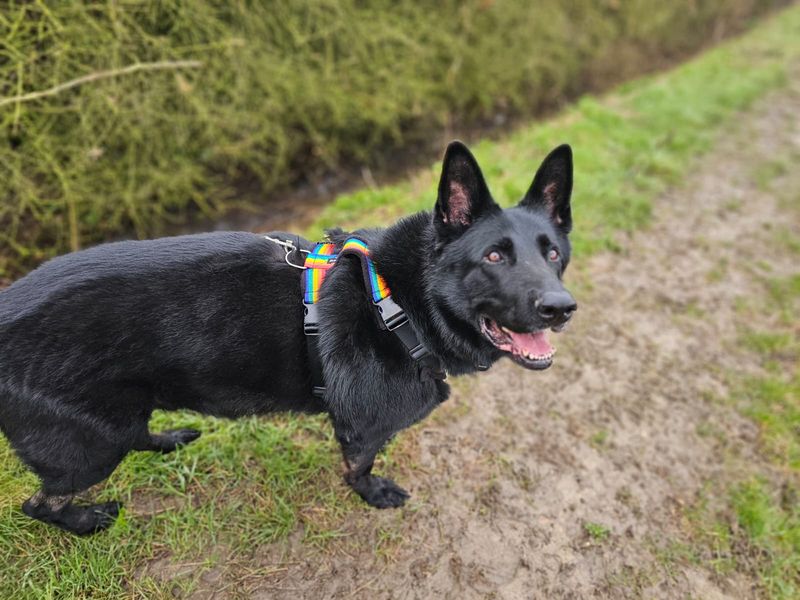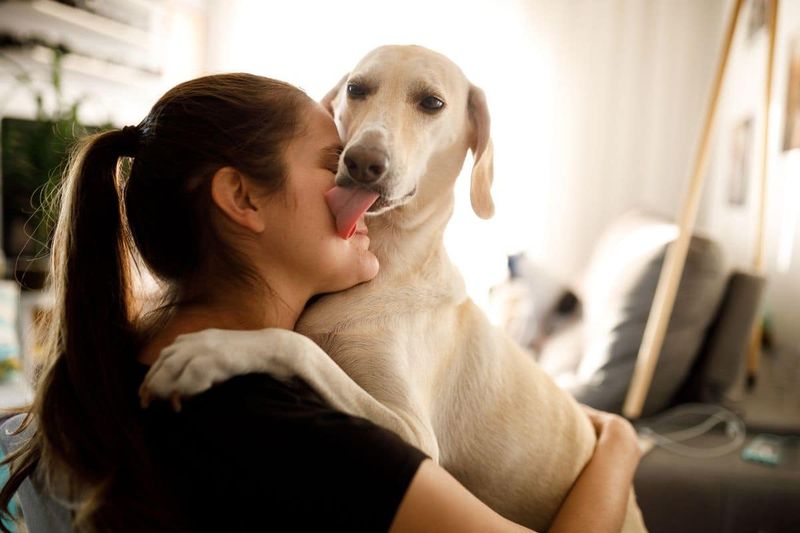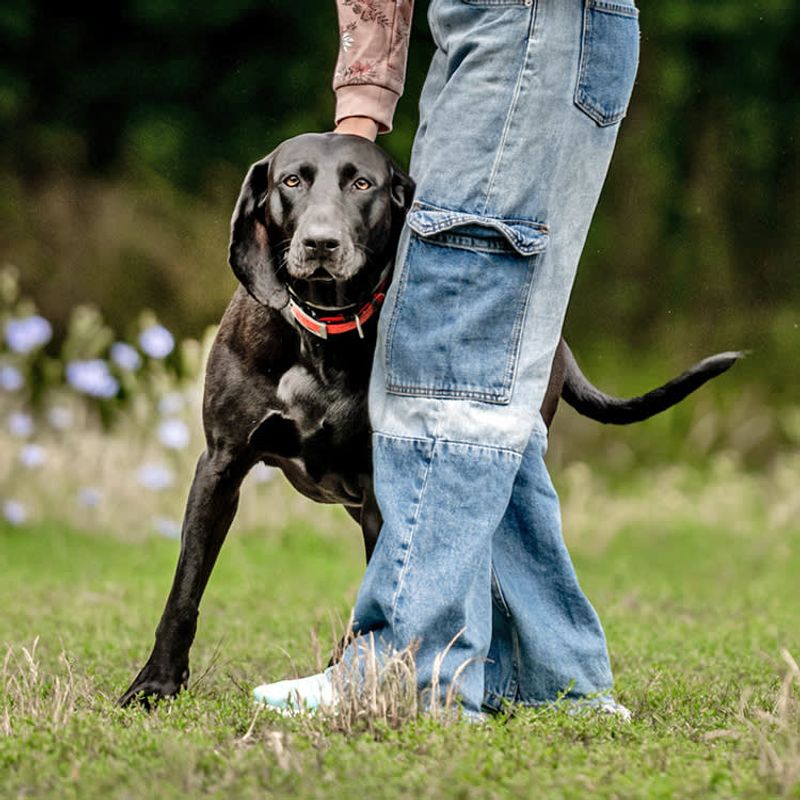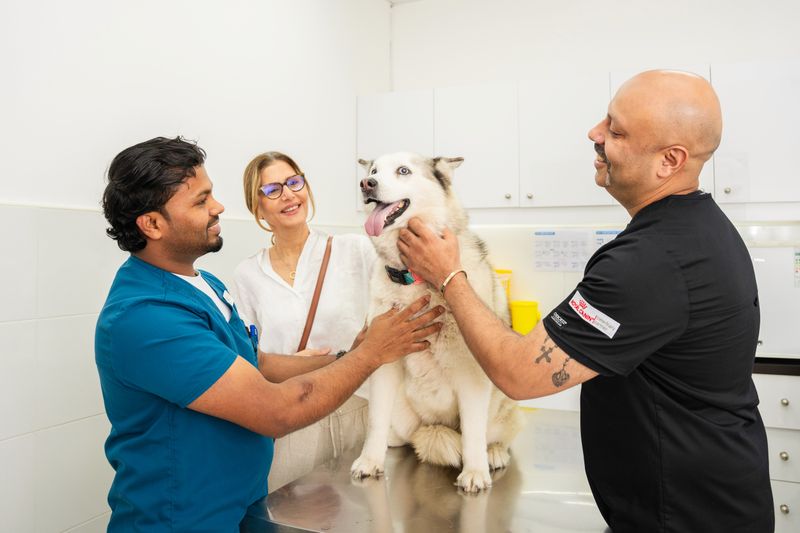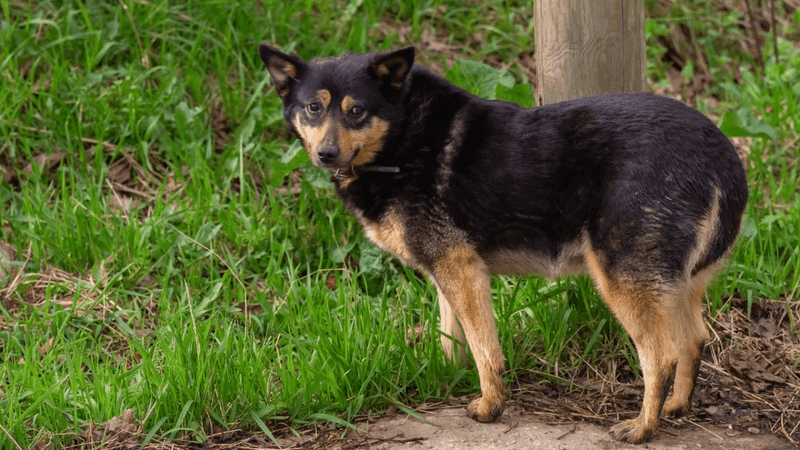Dogs have an incredible ability to communicate without uttering a single bark. Through various gestures, postures, and expressions, our canine companions convey emotions, intentions, and desires. This fascinating form of silent communication not only strengthens the bond between dogs and their humans but also reveals the depth of their intelligence and sociability. The following are 16 unique ways dogs express themselves without using their vocal cords.
Tail Wagging
The joyful rhythm of a dog’s tail wagging is a universal sign of happiness. However, the speed and direction of the wag can tell more than just joy. A high and fast wag often indicates excitement, while a slow, tentative wag might suggest caution or uncertainty.
Interestingly, research has shown that dogs wag to the right when they’re happy to see someone they know, and to the left when they encounter an unfamiliar or threatening situation. This subtlety adds layers to their non-verbal cues, enabling them to communicate complex emotions.
Ear Positioning
Ears are a dog’s radar, capturing the auditory world around them. When a dog’s ears are perked up and facing forward, it usually signifies attentiveness or curiosity. Flattening the ears back against the head often indicates submission or anxiety.
Dogs can move their ears independently, which helps them pinpoint sounds with accuracy. This ability not only aids in hunting or playing but also in conveying their emotional state to others, both human and canine. The positioning of a dog’s ears is a nuanced language in itself, reflecting their intricate social interactions.
Facial Expressions
A dog’s face can be as expressive as a human’s, with their eyes and eyebrows playing key roles in communication. Raised eyebrows can make dogs appear more approachable or inquisitive, while a narrowing of the eyes might signal discomfort or distrust.
Dogs also use their mouths to express emotions. A relaxed, open mouth may indicate contentment, while a tense, closed mouth might suggest stress. These facial cues are critical in understanding a dog’s feelings and intentions, allowing for deeper connections between dogs and their human companions.
Body Posture
The stance of a dog can speak volumes about its confidence and intentions. A dog standing tall with a straight back and raised head conveys assurance and possibly dominance. Conversely, a lowered posture with tucked tail often denotes submission or fear.
In social interactions, body language is crucial for dogs to communicate effectively. Subtle shifts, like leaning away or towards another being, help them express friendliness or aversion. Understanding these postures helps owners respond appropriately to their pet’s needs and emotions.
Pawing
Pawing is a charming and interactive way for dogs to grab attention or express a need. Whether it’s a gentle nudge to ask for a treat or a persistent tap to request playtime, this gesture is both endearing and communicative.
Some dogs even learn to use pawing as a tool to manipulate their environment or interact with toys. This behavior demonstrates their intelligence and adaptability, as they use their paws to engage with their surroundings and convey messages to their human companions.
Licking
Licking is a versatile form of communication in dogs, often associated with affection and bonding. When a dog licks a human, it’s commonly seen as a sign of love or gratitude. However, licking can also be a response to stress or anxiety, as it has a soothing effect on the dog.
In social structures, dogs lick each other to show submission or reinforce bonds within the pack. This behavior is deeply rooted in their evolutionary past, highlighting the importance of licking as a multifaceted tool for interaction.
Yawning
Yawning is not only a sign of tiredness but also a communicative gesture for dogs. Interestingly, dogs often yawn in response to human yawns, showcasing their empathetic nature. This mirroring behavior suggests that dogs can read human emotions and use yawning as a form of social bonding.
Moreover, a dog may yawn to diffuse tension or calm themselves in stressful situations. Understanding this silent signal can help owners better gauge their pet’s emotional state and provide comfort when needed.
Rolling Over
Rolling over is a delightful behavior that can indicate playfulness and submission. When a dog exposes its belly, it is a gesture of trust and vulnerability, often inviting interaction or a belly rub.
This behavior can also serve as a calming signal among dogs, helping to diffuse potential conflicts. By showcasing their trust, dogs communicate their peaceful intentions, enriching their social interactions with both humans and other dogs.
Sniffing
Sniffing is a dog’s primary way of exploring the world, with their keen sense of smell providing a wealth of information. When a dog sniffs another dog, they gather data about its identity, health, and emotional state.
This behavior is essential in canine communication, as scent conveys messages that are invisible to humans. Dogs also use sniffing to mark territory or detect changes in their environment, enhancing their understanding of the world around them.
Leaning
Leaning is a subtle but powerful way dogs show affection and seek comfort. When a dog leans against you, it’s often a sign of trust and a desire for closeness. This gesture reinforces the bond between dogs and their humans, fostering a sense of security.
Leaning can also indicate a dog’s need for support or reassurance in unfamiliar situations. By recognizing this behavior, owners can provide the necessary emotional support and strengthen their connection with their furry companions.
Whining
Whining is a vocalization that, while not barking, conveys a range of emotions. Dogs may whine to express excitement, anxiety, or a need for attention. This sound is often coupled with other body language, like tail wagging or pacing, to provide context.
By listening closely to the tone and accompanying behaviors, owners can decipher the reasons behind their dog’s whines. Understanding this form of communication can help address the underlying needs or concerns of the dog, enhancing their well-being.
Play Bow
The play bow is an iconic canine gesture that signals a desire for fun and interaction. By lowering their front body while keeping their rear elevated, dogs invite others to engage in play. This posture is a clear and friendly invitation, often followed by a joyful romp.
The play bow can also serve as an apology in dog language, diffusing tension and encouraging positive socialization. Recognizing this gesture allows owners to join in or facilitate play, strengthening the human-dog relationship.
Head Tilting
The charming tilt of a dog’s head is often a response to sounds or words they are trying to understand. This behavior not only makes them look endearing but also indicates their attentiveness and curiosity.
Head tilting is believed to help dogs better locate sounds and interpret human speech, enhancing their ability to communicate with us. This quirky gesture is more than just a cute pose; it reflects a dog’s desire to comprehend and interact with the world around them.
Barking
While barking is a vocal behavior, its absence or modification can also be communicative. Dogs may bark softly or in a controlled manner to express different emotions, like excitement or alertness, without causing alarm.
This variation in barking can convey subtleties in a dog’s message, allowing them to communicate effectively without resorting to loud or incessant barking. Understanding these nuances helps owners respond appropriately and fosters harmonious living with their pets.
Panting
Panting is a natural behavior for dogs to regulate their body temperature, but it also serves as a communication tool. Rapid panting can indicate stress or anxiety, while slower, relaxed panting might suggest contentment.
Observing a dog’s panting patterns can provide insights into their emotional and physical state. This awareness allows owners to address potential discomforts or provide reassurance, ensuring their pet’s comfort and happiness.
Tail Tucking
A tucked tail is a clear sign of fear or submission in dogs. This behavior reflects their vulnerability and desire to avoid conflict. In social hierarchies, tucking the tail can signal submission to a more dominant individual.
Recognizing this gesture is crucial for understanding a dog’s emotional state and responding with empathy and support. By addressing the source of fear or stress, owners can help their dogs regain confidence and feel secure.




